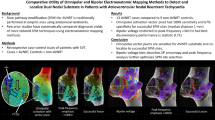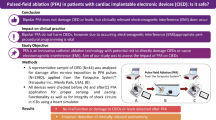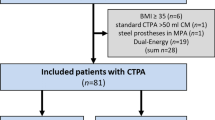Abstract
Background
Radiofrequency energy delivered throughout the cardiac cycle has the potential to cause thermal injury to the esophagus if the anatomical relationship between the posterior left atrium and the esophagus changes during cardiac motion.
Objective
To assess the posterior left atrial–esophageal relationship throughout the cardiac cycle.
Methods
In this study, the anatomical relationship between the posterior left atrium and the esophagus was assessed throughout the cardiac cycle in 10 consecutive patients. All patients underwent contrast-enhanced, ECG-gated CT scanning. Left atrial volumes and the esophageal structure were generated from the reconstructed data at 10 phases of the cardiac cycle from 5% to 95% of the R–R interval. The posterior left atrial–esophageal anatomical relationship was measured at four levels, the superior pulmonary vein ostial site, and the upper, mid and lower left atrium.
Results
There were significant variations in the left atrial–esophageal relationship in the 10 patients. The relative movement between the esophagus and the posterior left atrium throughout the cardiac cycle in the anteroposterior and right-to-left orientations was 0.55 ± 0.99 mm and 0.60 ± 1.02 mm (95% confidence interval, 2.03 and 1.98 respectively).
Conclusions
Under normal conditions, there is little change in the anatomical relationship between the posterior left atrium and the esophagus during the entire cardiac cycle. However, due to the interpatient variability at the esophageal location, identification of esophageal location may help prevent complications during catheter ablation procedures involving the left atrium.
Similar content being viewed by others
References
Gillinov, A. M., Pettersson, G., & Rice, T. (2001). Esophageal injury during radiofrequency ablation for atrial fibrillation. Journal of Thoracic and Cardiovascular Surgery, 122, 1239–1240.
Scanavacca, M. I., Ávila, A. D., Parga, J., & Sosa, E. (2004). Left atrial–esophageal fistula following radiofrequency catheter ablation of atrial fibrillation. Journal of Cardiovascular Electrophysiology, 15, 960–962.
Sonmez, B., Demirsoy, E., Yagan, N., Unal, M., Arbatli, H., Sener, D., et al. (2003). A fatal complication due to radiofrequency ablation for atrial fibrillation: Atrio-esophageal fistula. Annals of Thoracic Surgery, 76, 281–283.
Doll, N. A., Borger, M. A., Fabricius, A., Stephan, S., Gummert, J., Mohr, F. W., et al. (2003). Esophageal perforation during left atrial radiofrequency ablation: Is the risk too high? Journal of Thoracic and Cardiovascular Surgery, 125, 836–842.
Pappone, C., Oral, H., Santinelli, V., Vicedomini, G., Lang, C. C., Manguso, F., et al. (2004). Atrio-esophageal fistula as a complication of percutaneous transcatheter ablation of atrial fibrillation. Circulation, 109, 2724–2726.
Lemola, K., Sneider, M., Desjardins, B., Case, I., Han, J., Good, E., et al. (2004). Computed tomographic analysis of the anatomy of the left atrium and the esophagus. Implications for the left atrial catheter ablation. Circulation, 220, 3655–3660.
Sanchez-Quintana, D., Cabrera, J. A., Climent, V., Farre, J., de Mendonca, M. C., & Ho, S. Y. (2005). Anatomic relations between the esophagus and left atrium and relevance for ablation of atrial fibrillation. Circulation, 112, 1400–1405.
Cury, R. C., Abbara, S., Schmidt, S., Malchano, Z. J., Neuzil, P., Weichet, J., et al. (2005). Relationship of the esophagus and aorta to the left atrium and pulmonary veins: Implications for catheter ablation of atrial fibrillation. Heart Rhythm, 2, 1317–1323.
Sra, J., Krum, D., Hare, J., Okerlund, D., Thompson, H., Vass, M., et al. (2005). Feasibility and validation of registration of three-dimensional left atrial models derived from computed tomography with a noncontact cardiac mapping system. Heart Rhythm, 2, 55–63.
SAS/STAT users guide (1989). version 6, Carey. N.C. SAS institute, 261–268.
Good, E., Oral, H., Lemola, K., Han, J., Tamirisa, K., Igic, P., et al. (2005). Movement of the esophagus during left atrial catheter ablation for atrial fibrillation. Journal of the American College of Cardiology, 46, 2107–2110.
Author information
Authors and Affiliations
Corresponding author
Rights and permissions
About this article
Cite this article
Sra, J., Krum, D., Malloy, A. et al. Posterior left atrial–esophageal relationship throughout the cardiac cycle. J Interv Card Electrophysiol 16, 73–80 (2006). https://doi.org/10.1007/s10840-006-9031-7
Received:
Accepted:
Published:
Issue Date:
DOI: https://doi.org/10.1007/s10840-006-9031-7




